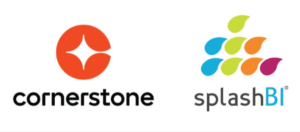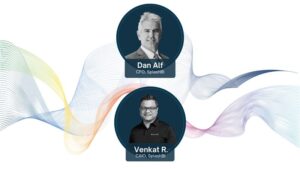Introduction
The modern workplace is in a state of constant flux. With technologies rapidly evolving and business environments growing increasingly complex, companies today face unprecedented challenges in adapting their workforce strategies. Leaders across functions are seeking ways to stay competitive and future-ready amidst an uncertain business landscape.
It is against this backdrop that the recent SplashBI panel discussion “HR Horizons 2024: Reflecting on 2023 and Preparing for the Future” served as an important and timely forum to discuss the forces reshaping the world of work. Click here to watch.
Featuring industry experts from UKG and SplashBI, the 60-minute session provided authoritative insights into the key developments impacting human resources today.
The discussion identified some of the most pressing challenges facing HR leaders – from skills shortage and development to integrating advanced technologies like AI into the workplace. The speakers also prescribed focused, data-driven solutions that businesses can adopt to get ahead of the curve and create forward-looking workplaces.
But most crucially, the panel discussion emphasized the need for organizations to understand employee pain points on an individual level, along with their diverse aspirations, preferences and needs. This comprehensive session explored 2023 trends, highlighting past undercurrents of anxiety stemming from the pandemic and fears of a looming recession, as well as prescribing actionable steps for organizations to be better prepared for the changes ahead.

As business environments grow more complex, the demand for resilient and adaptive leadership has never been more acute. This mounting need to future-proof leadership capabilities in the face of volatility was a pivotal theme discussed during the panel discussion.
The current business landscape demands leadership that extends far beyond traditional skills of planning and resource management. It calls for strategic foresight, change agility, and a deeply empathetic leadership style that can foster trust and engagement despite disruptions.
Specifically, organizations need to develop leaders who have a keen understanding of new technologies and can inspire teams to embrace innovation- forward-thinking leaders who can spot trends early and continually upskill teams for new challenges.
The panel highlighted that leadership today is about facilitating change, not dictating it. Organizations that invest in developing human-centered, purpose-driven and technologically-adept leaders will gain a sustained competitive advantage. With the right capabilities, leadership itself can drive transformation and future success.
Key Takeaways from the Session
The Evolving Employee-Employer Relationship
The discussion began with an in-depth look at the shifting relationship between employees and employers. Experts emphasized that as flexibility and mutual trust become integral, viewing workers through the outdated lens of age-based segmentation is proving inadequate.
Instead, organizations must acknowledge the individuality of their employees – their diverse needs, aspirations and preferences. Creating targeted opportunities based on interest rather than tenure is key. Experts stressed that the future workplace demands fundamentally rethinking these dynamics. Success will depend on how well companies can understand their employees and create personalized experiences.
Addressing the Pressing Challenge of Skills Shortages
Karina Monesson, Sr. Manager, HCM, Research and Advisory at UKG, highlighted that the majority of jobs in 2035 don’t exist even today. The emergence of innovative technologies is disrupting roles and necessitating new skills. In the next few years, this will question the agility of both employers and employees alike.
Further, Karina urged leaders and organizations to shift their focus inward to their existing talent pool. She explained, “We need to be doing a much better job as organizations of taking a step back and making sure that we have a very clear understanding of what skills are actually necessary for these roles.”
Organizations need to map skills not just for current needs, but 3-5 years ahead. Building this inventory enables targeted mining of talent within the organization through people analytics – far more cost-effective than external hiring.
Secondly, people analytics play a crucial role in mining talent data to identify transferable aptitudes within the company. This allows cost-effective upskilling and reskilling to fill skill gaps in roles, rather than going for an external hiring.
Additionally, continuous learning is imperative given the pace of change. Investing in human capital today through data-driven skills mapping and internal retraining ensures organizations stay competitive and future-ready.

The session also spotlighted how innovations like AI, machine learning and advanced analytics are reshaping the future of work across functions. However, merely acquiring technology is not enough. As Brianne Minnich, HCM Solutions Director at SplashBI pointed out the challenges of adopting a new solution across the organization- “Not a hundred percent people are going to be on board. They never are and they’re never going to be.”
She further emphasized the need to make employees fully aware on how implementing these tools will benefit them on an individual level. “I need to see the proof in the pudding before I totally make the leap… That’s where you just have to get the tools in front of the person.”
Preparing leaders and employees to adapt to new technologies will determine whether these innovations actually augment roles rather than displace jobs. Organizations must educate teams on how AI and automation can enhance efficiency, engagement and decision-making. This mindset shift is vital to realize the complete potential of workplace transformation.
1. Developing Adaptable Leaders to Manage Change
The session flagged leadership development as another critical investment area. With business environments evolving rapidly, organizations need managers who can steer with agility through uncertainty.
The panel discussion highlighted the importance of programs to cultivate strategic thinking, data literacy, change management, and communication skills. Leaders must be developed as true partners and coaches to their teams. They must drive a culture of trust and transparency while being adaptable themselves. Getting leadership development right will determine how well the companies navigate through the complexities that lay ahead of them.
2. Preparing Teams for New Technology Adoption
While discussing advanced tools like AI and machine learning, speakers addressed a key challenge – preparing employees for adoption. They highlighted how many organizations are still reliant on legacy systems and spreadsheet-driven processes.
Pushing teams directly into sophisticated tools without preparation could meet resistance. The session emphasized on the importance of change management and training for frictionless adoption processes. Employees must be educated on how these tools create value – by providing insights not visible via legacy systems and not replacing employees in their jobs. Often, employees themselves might not realize the potential that a solution has in store for them unless they learn to seamlessly interact with it.
“I think that leaders probably need to reassess kind of how that looks because they could probably make a lot of change if they just opened up some of those doors and allow their employees to be empowered and manage their HCM needs or their WFM needs.”
– Jose Cervantes, Manager, ERM Business Value Consulting, UKG.
A phased rollout process from the management highlighting the benefits of new technological adoption will be key in realizing the full benefits of the solution.
3. Leveraging Data to Shape Employee Experiences
With access to an unprecedented amount of workforce data, organizations have a pivotal opportunity to really understand their employees and cater to their needs. The session emphasized that metrics on performance, turnover, engagement, demographics and sentiment can help create personalized experiences. This is where diving deep into the ever-growing organizational data set using tools and technologies becomes imperative to get a much more intimate understanding of the workforce.
“Because with the economy the way it is today, giving everyone a huge raise, which is great way to improve morale and retention, but it’s not always feasible”
– Karina Monesson, Sr. Manager, HCM, Research and Advisory
Targeted interventions such as location-based benefits, mentorship opportunities, upskilling programs and tailored rewards and recognition can dramatically improve satisfaction. Speakers urged organizations to leverage data, not just evaluate it. Deriving actionable insights is key to understanding employee aspirations and keeping them motivated amidst constant change.
4. Driving Talent Management Through People Analytics
The panel discussion also positioned people analytics as foundational to building robust talent pipelines. Advanced analytics help create a skills inventory and identify capabilities in unexpected pockets of the organization. Instead of reflexive external hiring, this enables efficient internal mobility and redeployment.
Speakers also highlighted how analyzing data on employee sentiments, interests and aspirations enables optimal job rotations and successions. This boosts engagement while reducing the costs and effort involved in external recruitment. For people analytics success, organizations must break silos and integrate data across HR systems.
Unlock the Power of People Analytics with SplashBI
Combining the familiarity of Excel with visual analytics and AI-powered capabilities, SplashBI provides HR leaders with a comprehensive overview of workforce metrics from a single source of truth. The platform seamlessly connects and analyzes data from disparate HR systems to offer real-time actionable insights through interactive dashboards.
With SplashBI, critical questions around turnover, capability gaps, and predictive hiring needs can be answered at a glance through easy-to-digest visual funnel representations. Leaders save countless hours otherwise spent liaising with HR to access reports. Location-based attrition trends, skills heatmaps, and diversity analytics further empower strategic talent planning and mobility.
SplashBI also equips managers to have meaningful development conversations with team members by highlighting capability adjacencies and growth opportunities tailored to individual interests. Its conversational workflows deliver insights in a relatable human way that drives engagement.
SplashBI combines the scalability of enterprise-grade analytics with the human touch of people-centric experiences, turning the data of your employees into a strategic advantage.
The Road Ahead
As organizations look towards 2024, the imperatives are clear – promote individualized employee experiences, develop future-ready skills, enable efficiency through technology and build adaptable leadership. Now more than ever, companies must invest in tools that provide a holistic understanding of their workforce deeply, understand critical pain points and empower them to respond in an agile manner.
For those looking to dive deeper into the top trends shaping HR in 2024, Karina Monesson’s research offers invaluable insights. Explore the full report to stay ahead in creating a resilient and adaptive workplace: 2024 Megatrends in HR.








